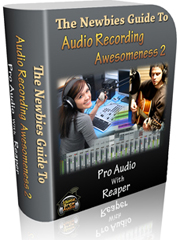 Our latest audio recording course is the Newbies Guide To Audio Recording Awesomeness 2: Pro Recording With Reaper, which is the second home recording course in our “Newbies Guide” series. The first course was designed for folks who have little or no budget for gear or software to start doing audio recording. Therefore, it makes use of the free recording program, Audacity, which you can download and start using immediately, and “any mic you happen to have,” including a $5.00 plastic computer mic.
Our latest audio recording course is the Newbies Guide To Audio Recording Awesomeness 2: Pro Recording With Reaper, which is the second home recording course in our “Newbies Guide” series. The first course was designed for folks who have little or no budget for gear or software to start doing audio recording. Therefore, it makes use of the free recording program, Audacity, which you can download and start using immediately, and “any mic you happen to have,” including a $5.00 plastic computer mic.
The first course is NOT a prerequisite for the second one! It is simply designed for those with a bit more of a budget for software and gear. It makes use of Reaper recording software, which is decidedly professional audio recording software (technically called a digital audio workstation or DAW), and yet whose cost is amazingly low. In fact, The Reaper folks have something they call the honest business model. First is the 30-day free trial, which is a fully functional version of the software AND doesn’t actually stop working after 30 days. Yes, you will get a notice telling you the software is not free after that time, but if you need more than 30 days, you can have more time to evaluate Reaper. Then – and this is the really amazing part – you decide whether to pay $225 or $60 for a full license to Reaper! What? Yup. If you are a business making more than $20,000 (USD) per year, then you should buy the commercial license for $225. If you don’t make that much, you pay $60. And nobody is going to check. It’s based on the honor system. I don’t know of anyone else who does this. Simply amazing.
Anyway, the Newbies Guide To Audio Recording Awesomeness 2: Pro Recording With Reaper also starts you from scratch and teaches the basics of audio recording – just like the first course – it simply goes further and teaches you a lot more cool stuff (time-saving voice-over automation tips and tricks, multi-track recording, MIDI, virtual instruments, and much more), mainly because Reaper is capable of doing all that stuff.
Click here for two free videos from the course.
Check out the video below, which is sort of a walk-through of the course:
Reaper Tutorial Home Recording Course Video
Found you on You Tube and really was impressed with your “dumbed down” approach for “newbies” in home studio recording. I’m using Reaper 3.5, with a Behringer 2-in/2-out interface, for keyboard and mic recording. Question: does your “Music Recording” or “Recording Tips & Techniques” contain the answer to stopping the unintended recording of tracks (that are playing back necessary audio) ONTO THE ARMED RECORDING TRACK, rather than the armed track just recording only the keyboard/vocal signal itself? If not, can you tell me if there’s something in Reaper I need to enable/disable to stop this “bleed over”? The Reaper manual doesn’t seem to address this anywhere! Not trying to pry a “feebie” from you, but can you help? I’m “dead in the water”, until I can solve this problem!
Thanks Brent,
Yes, that is something that is definitely covered in both volumes of The Newbies Guide to Audio Recording Awesomeness (Audacity and Reaper, respectively). By default, Reaper only records what is coming into any track that is armed for recording. So if your “already recorded” track is somehow being recorded onto a new track that you are trying to add to your song, the most common culprits are: 1. You use speakers instead of headphones to monitor the recorded track, or you accidentally leave the speakers on – which I have done!). Obviously that means that your mic is recording not only your singing (if that is the track you’re trying to add), but also what’s coming out of the speakers, which bleeds into the mic. The second main reason is if somehow your interface is not separating the input and output signals. For example, some people try to use a mixer in their home computer recording set-up, which you should NOT do unless you really, really, really, (get the idea?) know what you’re doing and where all the “gozintas” and “gozouttas” are going and coming from. I had a reader who asked a similar question to yours and I answered by way of a 2-part post called “Why You Should Not Use A Mixer In Your Home Recording Studio.” The reason is that the thing you are monitoring gets folded back into the input, causing both things – the thing you’re just listening to (and DON’T want to record…again) AND your overdub to record. If you are definitely not monitoring (even accidentally) using speakers when you overdub, then my money is on that second reason. You say you’re using a Behringer 2-in/2-out interface. Can you be more specific? If it’s the UCA222, I can pretty much guarantee that is the cause.
I highly recommend using an interface designed for multi-track recording, such as an M-Audio (now AVID) Fast Track or Focusrite Scarlett 2i. Both just about $100. I recently got the Focusrite and have been really happy with it. I actually tried to duplicate your problem and literally could not make it record the already-recorded track onto a subsequent overdubbing track.
Anyway, let me know what the model is and I think we can pinpoint the solution for you.
Cheers!
Ken